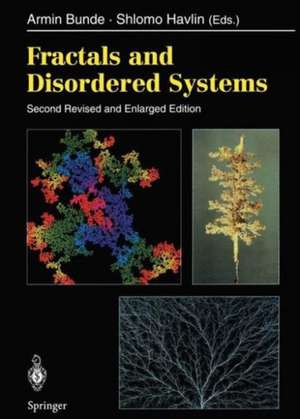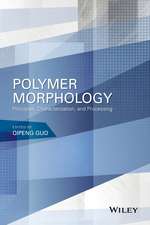Fractals and Disordered Systems
Editat de Armin Bunde, Shlomo Havlinen Limba Engleză Paperback – 29 mar 2012
Preț: 663.01 lei
Preț vechi: 872.38 lei
-24% Nou
Puncte Express: 995
Preț estimativ în valută:
126.86€ • 132.81$ • 104.97£
126.86€ • 132.81$ • 104.97£
Carte tipărită la comandă
Livrare economică 01-07 aprilie
Preluare comenzi: 021 569.72.76
Specificații
ISBN-13: 9783642848704
ISBN-10: 3642848702
Pagini: 436
Ilustrații: XXII, 408 p. 54 illus., 25 illus. in color.
Dimensiuni: 193 x 270 x 23 mm
Greutate: 0.92 kg
Ediția:2nd ed. 1996. Softcover reprint of the original 2nd ed. 1996
Editura: Springer Berlin, Heidelberg
Colecția Springer
Locul publicării:Berlin, Heidelberg, Germany
ISBN-10: 3642848702
Pagini: 436
Ilustrații: XXII, 408 p. 54 illus., 25 illus. in color.
Dimensiuni: 193 x 270 x 23 mm
Greutate: 0.92 kg
Ediția:2nd ed. 1996. Softcover reprint of the original 2nd ed. 1996
Editura: Springer Berlin, Heidelberg
Colecția Springer
Locul publicării:Berlin, Heidelberg, Germany
Public țintă
ResearchCuprins
1 Fractals and Multifractals: The Interplay of Physics and Geometry (With 30 Figures).- 1.1 Introduction.- 1.2 Nonrandom Fractals.- 1.3 Random Fractals: The Unbiased Random Walk.- 1.4 The Concept of a Characteristic Length.- 1.5 Functional Equations and Fractal Dimension.- 1.6 An Archetype: Diffusion Limited Aggregation.- 1.7 DLA: Fractal Properties.- 1.8 DLA: Multifractal Properties.- 1.9 Scaling Properties of the Perimeter of 2d DLA: The “Glove” Algorithm.- 1.10 Multiscaling.- 1.11 The DLA Skeleton.- 1.12 Applications of DLA to Fluid Mechanics.- 1.13 Applications of DLA to Dendritic Growth.- 1.14 Other Fractal Dimensions.- 1.15 Surfaces and Interfaces.- 1.A Appendix: Analogies Between Thermodynamics and Multifractal Scaling.- References.- 2 Percolation I (With 24 Figures).- 2.1 Introduction.- 2.2 Percolation as a Critical Phenomenon.- 2.3 Structural Properties.- 2.4 Exact Results.- 2.5 Scaling Theory.- 2.6 Related Percolation Problems.- 2.7 Numerical Approaches.- 2.8 Theoretical Approaches.- 2.A Appendix: The Generating Function Method.- References.- 3 Percolation II (With 20 Figures).- 3.1 Introduction.- 3.2 Anomalous Transport in Fractals.- 3.3 Transport in Percolation Clusters.- 3.4 Fractons.- 3.5 ac Transport.- 3.6 Dynamical Exponents.- 3.7 Multifractals.- 3.8 Related Transport Problems.- References.- 4 Fractal Growth (With 4 Figures).- 4.1 Introduction.- 4.2 Fractals and Multifractals.- 4.3 Growth Models.- 4.4 Laplacian Growth Model.- 4.5 Aggregation in Percolating Systems.- 4.6 Crossover in Dielectric Breakdown with Cutoffs.- 4.7 Is Growth Multifractal?.- 4.8 Conclusion.- References.- 5 Fractures (With 18 Figures).- 5.1 Introduction.- 5.2 Some Basic Notions of Elasticity and Fracture.- 5.3 Fracture as a Growth Model.- 5.4 Modelisation of Fracture on aLattice.- 5.5 Deterministic Growth of a Fractal Crack.- 5.6 Scaling Laws of the Fracture of Heterogeneous Media.- 5.7 Hydraulic Fracture.- 5.8 Conclusion.- References.- 6 Transport Across Irregular Interfaces: Fractal Electrodes, Membranes and Catalysts (With 8 Figures).- 6.1 Introduction.- 6.2 The Electrode Problem and the Constant Phase Angle Conjecture.- 6.3 The Diffusion Impedance and the Measurement of the Minkowski-Bouligand Exterior Dimension.- 6.4 The Generalized Modified Sierpinski Electrode.- 6.5 A General Formulation of Laplacian Transfer Across Irregular Surfaces.- 6.6 Electrodes, Roots, Lungs,.- 6.7 Fractal Catalysts.- 6.8 Summary.- References.- 7 Fractal Surfaces and Interfaces (With 27 Figures).- 7.1 Introduction.- 7.2 Rough Surfaces of Solids.- 7.3 Diffusion Fronts: Natural Fractal Interfaces in Solids.- 7.4 Fractal Fluid-Fluid Interfaces.- 7.5 Membranes and Tethered Surfaces.- 7.6 Conclusions.- References.- 8 Fractals and Experiments (With 18 Figures).- 8.1 Introduction.- 8.2 Growth Experiments: How to Make a Fractal.- 8.3 Structure Experiments: How to Determine the Fractal Dimension.- 8.4 Physical Properties.- 8.5 Outlook.- References.- 9 Cellular Automata (With 6 Figures).- 9.1 Introduction.- 9.2 A Simple Example.- 9.3 The Kauffman Model.- 9.4 Classification of Cellular Automata.- 9.5 Recent Biologically Motivated Developments.- 9.A Appendix.- References.- 10 Exactly Self-similar Left-sided Multifractals with new Appendices B and C by Rudolf H. Riedi and Benoit B. Mandelbrot (With 10 Figures).- 10.1 Introduction.- 10.2 Nonrandom Multifractals with an Infinite Base.- 10.3 Left-sided Multifractality with Exponential Decay of Smallest Probability.- 10.4 A Gradual Crossover from Restricted to Left-sided Multifractals.- 10.5 Pre-asymptotics.- 10.6 Miscellaneous Remarks.- 10.7 Summary.- 10.A Details of Calculations and Further Discussions.- 10.B Multifractal Formalism for Infinite Multinomial Measures, by R.H. Riedi and B.B. Mandelbrot.- 10.C The Minkowski Measure and Its Left-sided f(?), by B.B. Mandelbrot.- References.
Textul de pe ultima copertă
Fractals and disordered systems have recently become the focus of intense interest in research. This book discusses in great detail the effects of disorder on mesoscopic scales (fractures, aggregates, colloids, surfaces and interfaces, glasses and polymers) and presents tools to describe them in mathematical language. A substantial part is devoted to the development of scaling theories based on fractal concepts. In 10 chapters written by leading experts in the field, the reader is introduced to basic concepts and techniques in disordered systems and is led to the forefront of current research. In each chapter, the connection between theory and experiment is emphasized, and a special chapter on "Fractals and Experiment" presents experimental studies of fractal systems. This second edition has been substantially revised and updates the literature in this important field. It is pedagogically written and so will be useful for students, teachers, and scientists who want to become familiar with this facinating subject.










